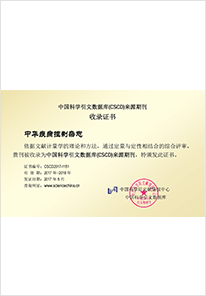2021 Vol. 25, No. 5
Display Method:
2021, 25(5): 497-499.
doi: 10.16462/j.cnki.zhjbkz.2021.05.001
Abstract:
2021, 25(5): 500-503.
doi: 10.16462/j.cnki.zhjbkz.2021.05.002
Abstract:
2021, 25(5): 504-508.
doi: 10.16462/j.cnki.zhjbkz.2021.05.003
Abstract:
2021, 25(5): 509-514.
doi: 10.16462/j.cnki.zhjbkz.2021.05.004
Abstract:
2021, 25(5): 515-520, 546.
doi: 10.16462/j.cnki.zhjbkz.2021.05.005
Abstract:
2021, 25(5): 521-527.
doi: 10.16462/j.cnki.zhjbkz.2021.05.006
Abstract:
2021, 25(5): 528-533, 540.
doi: 10.16462/j.cnki.zhjbkz.2021.05.007
Abstract:
2021, 25(5): 534-540.
doi: 10.16462/j.cnki.zhjbkz.2021.05.008
Abstract:
2021, 25(5): 541-546.
doi: 10.16462/j.cnki.zhjbkz.2021.05.009
Abstract:
2021, 25(5): 552-558, 588.
doi: 10.16462/j.cnki.zhjbkz.2021.05.011
Abstract:
2021, 25(5): 559-565.
doi: 10.16462/j.cnki.zhjbkz.2021.05.012
Abstract:
2021, 25(5): 566-570,576.
doi: 10.16462/j.cnki.zhjbkz.2021.05.013
Abstract:
2021, 25(5): 571-576.
doi: 10.16462/j.cnki.zhjbkz.2021.05.014
Abstract:
2021, 25(5): 577-582.
doi: 10.16462/j.cnki.zhjbkz.2021.05.015
Abstract:
2021, 25(5): 583-588.
doi: 10.16462/j.cnki.zhjbkz.2021.05.016
Abstract:
2021, 25(5): 589-593.
doi: 10.16462/j.cnki.zhjbkz.2021.05.017
Abstract:
2021, 25(5): 594-599.
doi: 10.16462/j.cnki.zhjbkz.2021.05.018
Abstract:
2021, 25(5): 600-604,611.
doi: 10.16462/j.cnki.zhjbkz.2021.05.019
Abstract:
2021, 25(5): 605-611.
doi: 10.16462/j.cnki.zhjbkz.2021.05.020
Abstract:
2021, 25(5): 612-615.
doi: 10.16462/j.cnki.zhjbkz.2021.05.021
Abstract:
2021, 25(5): 616-620.
doi: 10.16462/j.cnki.zhjbkz.2021.05.022
Abstract:


 Email alert
Email alert RSS
RSS Abstract
Abstract HTML
HTML PDF
PDF





